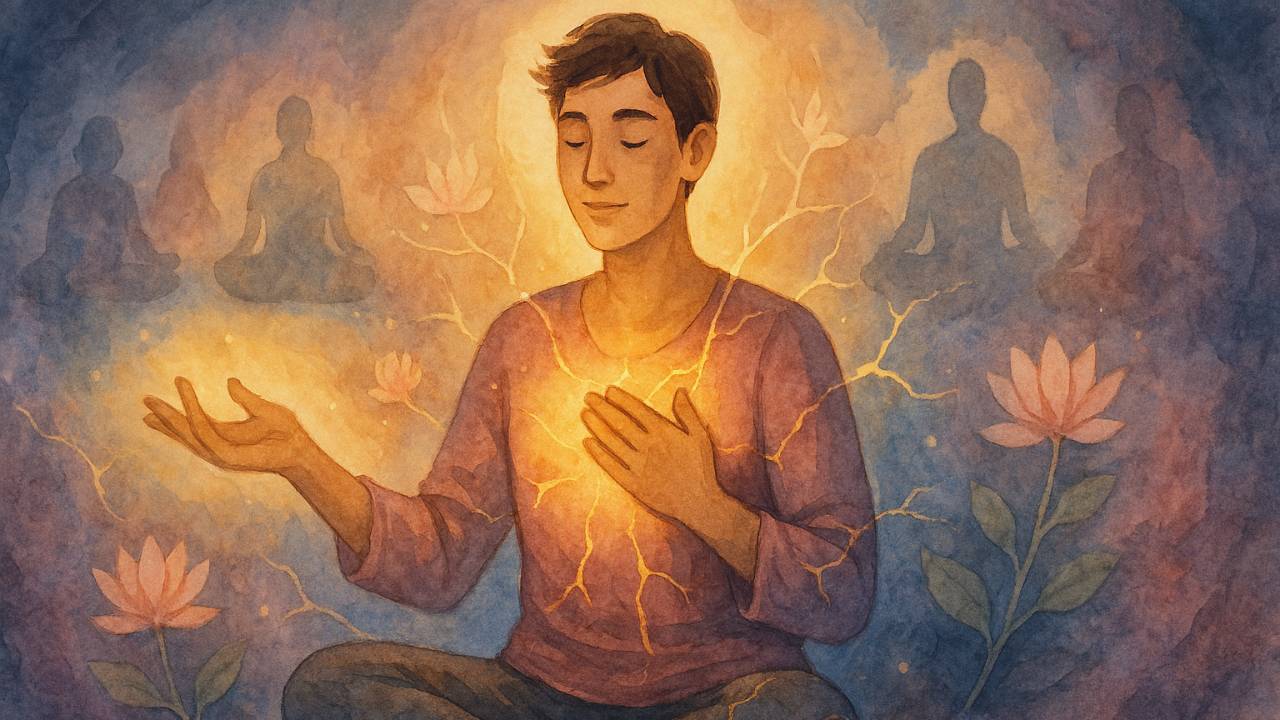Why We Teach What We Need to Learn: The Teacher's Healing Journey

One of the most common and paralyzing fears that holds aspiring meditation teachers back is the belief that they are not "healed enough." You might look at your own life, with its anxieties, its unresolved issues, and its messy imperfections, and think, “Who am I to guide others when I’m still on my own journey? I need to be perfect first.”
This feeling of inadequacy is nearly universal. But what if this belief is fundamentally flawed? What if your ongoing healing process is not a disqualifier, but rather your greatest qualification? The truth is, we are often called to teach what we need to learn. Your struggles, your vulnerabilities, and your deep desire for healing are the very things that will make you a compassionate, relatable, and profoundly effective guide.
Your Wounds Are Your Wisdom
The most powerful teaching comes not from a place of perfect enlightenment, but from the heart of the human experience. When you are actively working through a challenge in your own life, you are in the trenches of that experience. Your understanding is not theoretical; it is visceral, immediate, and real.
This is why some of the most impactful meditation courses are born from a teacher's personal struggle:
- A course on setting boundaries is created by someone who is learning to say "no" and honor their own needs.
- A workshop on inner child healing is led by a guide who is actively tending to their own childhood wounds.
- A meditation on navigating heartbreak is offered by a teacher who is in the midst of their own grieving process.
When you teach from this place, you bring an incredible amount of love, care, and emotion to your guidance. You are not speaking down from a mountaintop; you are walking the path alongside your students. This creates a powerful bond of trust and shared humanity. Your students feel seen and understood because you genuinely do understand.
Teaching as a Path to Deeper Healing
The act of teaching can be a profound catalyst for your own healing. It's a well-known principle that to truly master a subject, you must teach it. When you commit to guiding others through a particular challenge, you are also committing to a deeper level of engagement with that challenge yourself.
The process works in several ways:
- It solidifies your understanding: In order to explain a concept to others, you must first clarify it for yourself. The act of creating a course or guiding a meditation forces you to distill your experiences into clear, actionable wisdom.
- It locks in the learning: By sharing the tools and insights that have helped you, you reinforce those lessons within yourself. Teaching becomes a way of integrating your healing on a deeper level.
- It connects you to purpose: Finding what breaks your heart is often how you find your purpose. When you use your pain to help alleviate the suffering of others, it transforms your struggle into a meaningful offering.
Don't wait until you feel "healed" to start teaching. Your journey is your curriculum. The very thing you are working to heal in yourself is the gift you are meant to share with the world.
Overcoming Comparison and Scarcity
As you step onto the teaching path, it's natural to encounter feelings of jealousy and comparison. You might see other teachers who seem more successful or have a larger following and fall into a scarcity mindset, thinking, "What do they have that I don't?" or "There's not enough room for me."
This is a mistake, but it's a common one that you will have to work through. This inner critic, with its whiny, demanding voice, can shut you down if you let it.
Here’s how to work with these feelings:
- Recognize them as part of the journey: These feelings don't mean you're a bad person or not cut out for this work. They are a normal part of the human experience. Acknowledge them without judgment.
- Stay connected to your "why": When feelings of comparison arise, return to your core motivation. Remember that you are doing this because you love it and because you have a unique gift to offer.
- Embrace abundance: There is enough room for everyone. Each teacher, with their unique style and message, will attract the students who are meant for them. Another teacher's success does not diminish your own potential. Celebrate them, learn from them, and then return to your own authentic path.
Your journey is not a race against others. It is a slow, sacred unfolding. Stay connected to what wants to come through you, and trust that it will find its way to those who need to hear it.
The Invitation to Begin
The call to teach is not an invitation to be perfect. It is an invitation to be real. It is a call to take your life, with all its beauty and all its brokenness, and offer it in service to others. You are not healed, and that is precisely why you are ready.
So, to the person who feels they don't have enough wisdom or experience, I say this: you have exactly what you need. You have your journey. You have your heart. And you have the courage to teach what you need to learn. That is more than enough.
If you are ready to embrace your journey and learn how to transform your personal healing into powerful, heart-centered teaching, we invite you to explore our Meditation Teacher Training program. It is a space where you can be fully yourself, learn the art of guidance, and step confidently onto your path as a teacher.



